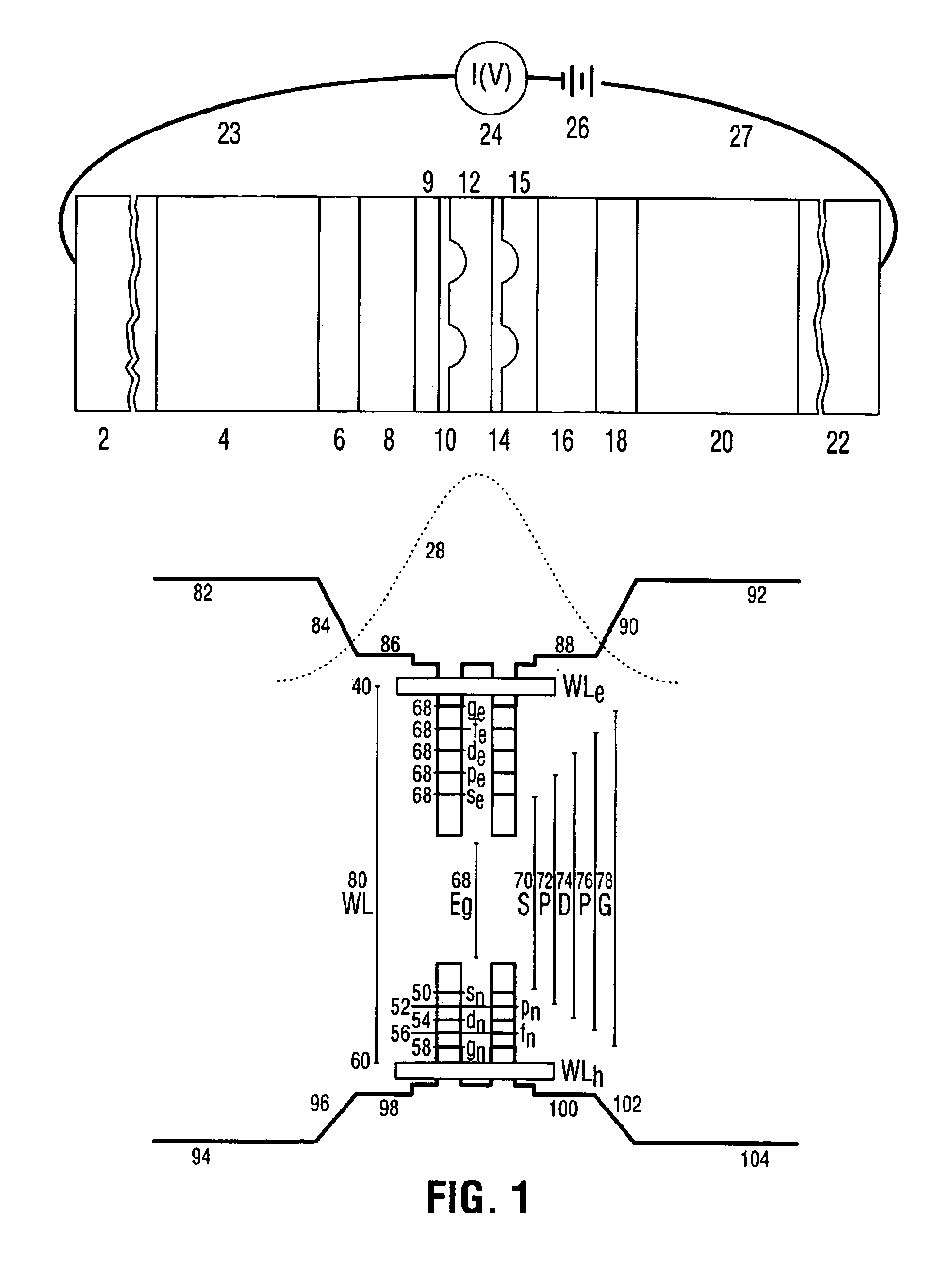Unlike the density-of-state of bulk material and of quantum wells, the electronic configuration of low-dimensional nano-structures, herein defined as quantum wires (one- or quasi-one dimensional structures) or quantum dots (zero or quasi-zero dimensional structures), will allow the saturation of their reduced density-of-states over a wide range of energies because the total number of available states is orders of magnitude smaller than for quantum wells. This will permit the production of
population inversions and lasing over wide range of wavelengths. Also, it is possible to produce Self-Assembled
Quantum Dots (QD) by
epitaxy using highly strained semiconductors, and to have
good control over their zero-dimensional density-of-state. Such quantum dots can be grown in a
laser diode configuration with conventional techniques, and the carriers will be injected electrically in the QD
laser diode. To obtain the tunability in such a QD laser
diode having a wide gain spectrum, an
external cavity is used. The resulting QD tunable
external cavity (QD-TEC) laser retains the efficiency and convenience of conventional semiconductor laser diodes, and yet is tunable over hundreds of nanometers by choosing the low-dimensional
electronic structure of the QD and the optical properties of the external cavity.
The QD laser
diode preferably comprises multiple
layers of
semiconductor materials including a least one
quantum dot layer in an active region between an
electron emitter layer, allowing the injection of electrons towards the quantum dots, and a hole emitter layer, allowing the injection of holes towards the quantum dots. The composition and
doping of the materials is chosen so that the relative optical constants, bandgaps, and
conductivity of the
layers establish an effective guiding of the optical
modes in a cavity formed perpendicular to the plane of the
layers, as well as efficient carrier injection when an
electric field is applied with the proper forward-bias polarity.
The active region is preferably not doped to minimize loses of the guided optical
modes. Intermediate layers with chosen bandgap and
doping can also be introduced between the active region and the emitter layers to tailor the optical guiding and the optical and electrical properties of the laser diode. The current injection and the optical mode guided in the QD laser diode material are preferably confined laterally to tailor the electrical, thermal, and optical characteristic of the QD-TEC laser. The current injection in the QD laser diode material might preferably be confined longitudinally to tailor the electrical, thermal, and optical characteristic of the QD-TEC laser. The longitudinal confinement of the optical mode guided in the QD laser diode material is preferably adjusted by changing the
reflectivity of a front and a back
facet individually to tailor the electrical, thermal, and optical characteristic of the QD-TEC laser. It might be preferable to regulate the temperature and / or remove
excess heat generated by the operation of the QD laser diode with the help of a temperature regulating device.
In another aspect the invention provides a method of producing low-dimensionality laser diodes having an adjustable gain spectrum based on a quantum material with low-dimensional density-of-states which relies on self-assembled quantum dots obtained by spontaneous island formation during
epitaxy of highly strained semiconductors, comprising selecting a barrier material and a quantum material such that the degree of lattice-mismatch dictates a
critical thickness required to obtain spontaneous island formation, and the bandgap difference determines a possible number of confined states in conjunction with the
energy spectrum of the low-dimensional states; growing some thickness of said barrier material in an active region between an
electron emitting layer and a hole emitting layer on a substrate, said
electron and hole emitting layers having a
lattice constant close to that of said substrate; depositing, at a specified growth rate, said quantum material at a temperature which will produce quantum dots having the appropriate size and shape to obtain said low-dimensionality density-of-states; ceasing the growth of said quantum material after the desired number of quantum dots per unit area is reached; waiting a specified amount of time to allow for the self-assembling growth to form the quantum dots in shapes and sizes which will give said low-dimensionality density-of-states; and growing some thickness of said barrier material to cover the quantum dots and return to a planar growth front at a substrate temperature which may be varied during the growth and which will optimize the quality of the quantum dots.
 Login to View More
Login to View More  Login to View More
Login to View More 


